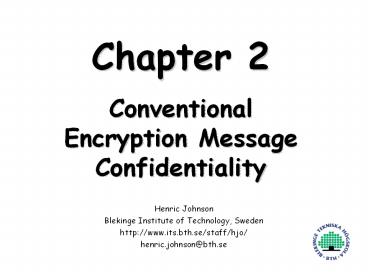Conventional Encryption Message Confidentiality - PowerPoint PPT Presentation
Title:
Conventional Encryption Message Confidentiality
Description:
Security depends on the secrecy of the key, not the ... Blowfish. Easy to implement. High execution speed. Run in less than 5K of memory. Henric Johnson ... – PowerPoint PPT presentation
Number of Views:535
Avg rating:3.0/5.0
Title: Conventional Encryption Message Confidentiality
1
Chapter 2
- Conventional Encryption Message Confidentiality
Henric Johnson Blekinge Institute of Technology,
Sweden http//www.its.bth.se/staff/hjo/ henric.joh
nson_at_bth.se
2
Outline
- Conventional Encryption Principles
- Conventional Encryption Algorithms
- Cipher Block Modes of Operation
- Location of Encryption Devices
- Key Distribution
3
Conventional Encryption Principles
- An encryption scheme has five ingredients
- Plaintext
- Encryption algorithm
- Secret Key
- Ciphertext
- Decryption algorithm
- Security depends on the secrecy of the key, not
the secrecy of the algorithm
4
Conventional Encryption Principles
5
Cryptography
- Classified along three independent dimensions
- The type of operations used for transforming
plaintext to ciphertext - The number of keys used
- symmetric (single key)
- asymmetric (two-keys, or public-key encryption)
- The way in which the plaintext is processed
6
Average time required for exhaustive key search
Key Size (bits) Number of Alternative Keys Time required at 106 Decryption/µs
32 232 4.3 x 109 2.15 milliseconds
56 256 7.2 x 1016 10 hours
128 2128 3.4 x 1038 5.4 x 1018 years
168 2168 3.7 x 1050 5.9 x 1030 years
7
Feistel Cipher Structure
- Virtually all conventional block encryption
algorithms, including DES have a structure first
described by Horst Feistel of IBM in 1973 - The realization of a Fesitel Network depends on
the choice of the following parameters and design
features (see next slide)
8
Feistel Cipher Structure
- Block size larger block sizes mean greater
security - Key Size larger key size means greater security
- Number of rounds multiple rounds offer
increasing security - Subkey generation algorithm greater complexity
will lead to greater difficulty of cryptanalysis. - Fast software encryption/decryption the speed of
execution of the algorithm becomes a concern
9
(No Transcript)
10
Conventional Encryption Algorithms
- Data Encryption Standard (DES)
- The most widely used encryption scheme
- The algorithm is reffered to the Data Encryption
Algorithm (DEA) - DES is a block cipher
- The plaintext is processed in 64-bit blocks
- The key is 56-bits in length
11
(No Transcript)
12
(No Transcript)
13
DES
- The overall processing at each iteration
- Li Ri-1
- Ri Li-1 F(Ri-1, Ki)
- Concerns about
- The algorithm and the key length (56-bits)
14
Time to break a code (106 decryptions/µs)
15
Triple DEA
- Use three keys and three executions of the DES
algorithm (encrypt-decrypt-encrypt) - C ciphertext
- P Plaintext
- EKX encryption of X using key K
- DKY decryption of Y using key K
- Effective key length of 168 bits
C EK3DK2EK1P
16
Triple DEA
17
Other Symmetric Block Ciphers
- International Data Encryption Algorithm (IDEA)
- 128-bit key
- Used in PGP
- Blowfish
- Easy to implement
- High execution speed
- Run in less than 5K of memory
18
Other Symmetric Block Ciphers
- RC5
- Suitable for hardware and software
- Fast, simple
- Adaptable to processors of different word lengths
- Variable number of rounds
- Variable-length key
- Low memory requirement
- High security
- Data-dependent rotations
- Cast-128
- Key size from 40 to 128 bits
- The round function differs from round to round
19
Cipher Block Modes of Operation
- Cipher Block Chaining Mode (CBC)
- The input to the encryption algorithm is the XOR
of the current plaintext block and the preceding
ciphertext block. - Repeating pattern of 64-bits are not exposed
20
(No Transcript)
21
Location of Encryption Device
- Link encryption
- A lot of encryption devices
- High level of security
- Decrypt each packet at every switch
- End-to-end encryption
- The source encrypt and the receiver decrypts
- Payload encrypted
- Header in the clear
- High Security Both link and end-to-end
encryption are needed (see Figure 2.9)
22
(No Transcript)
23
Key Distribution
- A key could be selected by A and physically
delivered to B. - A third party could select the key and physically
deliver it to A and B. - If A and B have previously used a key, one party
could transmit the new key to the other,
encrypted using the old key. - If A and B each have an encrypted connection to a
third party C, C could deliver a key on the
encrypted links to A and B.
24
Key Distribution (See Figure 2.10)
- Session key
- Data encrypted with a one-time session key.At the
conclusion of the session the key is destroyed - Permanent key
- Used between entities for the purpose of
distributing session keys
25
(No Transcript)
26
Recommended Reading
- Stallings, W. Cryptography and Network Security
Principles and Practice, 2nd edition. Prentice
Hall, 1999 - Scneier, B. Applied Cryptography, New York
Wiley, 1996 - Mel, H.X. Baker, D. Cryptography Decrypted.
Addison Wesley, 2001































